The Association for Mormon Letters’ AML Awards were presented online on June 5, 2021. You can watch the awards ceremony, emceed by Eric W. Jepson, and featuring remarks from many of the winners, at YouTube here. Below is each award winner, along with the award citation written by the judges.
 John S. Bennion was presented with the Association for Mormon Letters Lifetime Achievement Award. You can watch the AML conference panel honoring him, featuring Darlene Young, Gideon Burton, Dennis Clark, and Alison Maeser Brimley, here.
John S. Bennion was presented with the Association for Mormon Letters Lifetime Achievement Award. You can watch the AML conference panel honoring him, featuring Darlene Young, Gideon Burton, Dennis Clark, and Alison Maeser Brimley, here.
 Steven L. Peck was presented with the Smith-Pettit Foundation Award for Outstanding Contribution to Mormon Letters. You can watch the AML conference panel honoring him, featuring (Kylie Turley, Mattathias Westwood, Rosalynde Welsh, and George Handley), here.
Steven L. Peck was presented with the Smith-Pettit Foundation Award for Outstanding Contribution to Mormon Letters. You can watch the AML conference panel honoring him, featuring (Kylie Turley, Mattathias Westwood, Rosalynde Welsh, and George Handley), here.
Special Award in Religious Nonfiction
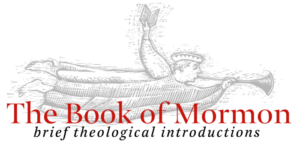 The Book of Mormon: Brief Theological Introductions. The Neal A. Maxwell Institute for Religious Scholarship
The Book of Mormon: Brief Theological Introductions. The Neal A. Maxwell Institute for Religious Scholarship
General editors: Philip Barlow and Spencer Fluhman
Series editors: D. Morgan Davis, James E. Faulconer, Kristine Haglund, Joseph M. Spencer, Rosalynde Welch
Authors: Joseph M. Spencer, Terryl L. Givens, Deidre Nicole Green, Sharon J. Harris, James E. Faulconer, Kylie Turley, Mark Wrathall, Kimberly Berkey, Daniel Becerra, Adam S. Miller, Rosalynde Frandsen Welch, David F. Holland.
Illustrator: Brian Kershisnik. Designer: Doug Thomas
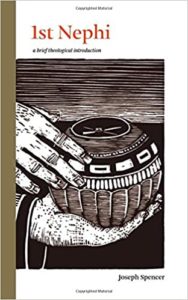 The Book of Mormon: Brief Theological Introductions series is a treasure. Twelve books provide accessible, thoughtful, and above all, incredibly engaging theological introductions to the books of the Book of Mormon. In the context of this series, “theology” designates the project of talking about God’s work in the world, specifically here through carefully thinking about scripture. It is not doctrinal nor dogmatic. While the authors are trained in the academy, their positions are widely varied, and that variety of experience and perspective brings an unexpected richness to this project. Each volume not only provides new insights into the Book of Mormon itself, but also into the concept of what it means to be a scripture-reading people. As stated in the series introduction: “individual series authors offer unique approaches but, taken together, they model a joint invitation to readers to engage scripture in his or her own way. […] No volume pretends to be the final word on theological reflection for its part of the Book of Mormon. Varied perspectives and methodologies are evident throughout. This is intentional” (ix). This intentional commitment to community produces a series that is, at heart, invitational. The Maxwell Institute is to be commended for this exceptional project—thoughtful yet accessible scholarship, beautifully produced (the physical volumes are truly gorgeous), all designed to invite us to continue, seeking Christ together again and again throughout the Book of Mormon.
The Book of Mormon: Brief Theological Introductions series is a treasure. Twelve books provide accessible, thoughtful, and above all, incredibly engaging theological introductions to the books of the Book of Mormon. In the context of this series, “theology” designates the project of talking about God’s work in the world, specifically here through carefully thinking about scripture. It is not doctrinal nor dogmatic. While the authors are trained in the academy, their positions are widely varied, and that variety of experience and perspective brings an unexpected richness to this project. Each volume not only provides new insights into the Book of Mormon itself, but also into the concept of what it means to be a scripture-reading people. As stated in the series introduction: “individual series authors offer unique approaches but, taken together, they model a joint invitation to readers to engage scripture in his or her own way. […] No volume pretends to be the final word on theological reflection for its part of the Book of Mormon. Varied perspectives and methodologies are evident throughout. This is intentional” (ix). This intentional commitment to community produces a series that is, at heart, invitational. The Maxwell Institute is to be commended for this exceptional project—thoughtful yet accessible scholarship, beautifully produced (the physical volumes are truly gorgeous), all designed to invite us to continue, seeking Christ together again and again throughout the Book of Mormon.
Special Award for Nonfiction
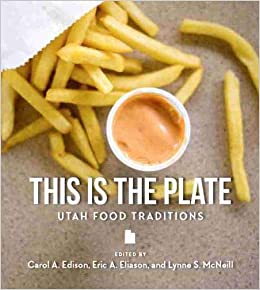 This Is the Plate: Utah Food Traditions. Edited by Carol Edison, Eric A. Eliason, Lynne S McNeill. University of Utah Press.
This Is the Plate: Utah Food Traditions. Edited by Carol Edison, Eric A. Eliason, Lynne S McNeill. University of Utah Press.
This year the Association for Mormon Letters is presenting a special award to a book for its cultural contributions that fit none of the existing categories. The book—the first of its kind–is a beautifully-produced collection of short ethnographic and sociohistorical pieces about Utah’s “distinctive food heritage,” with photographs, recipes, and informative, wry, and witty commentary. Edited by Carol A. Edison, Eric A. Eliason, and Lynne S. McNeill, this delightful coffee (or Postum) table volume contains entries by over sixty authors on such varied regionally gastronomie-relevant topics as green Jell-o; Hotel Utah hard rolls; and breweries in nineteenth-century Logan. Of special note are the contributions by Native American, Latino, and other minority authors who write on their heritage and foodways. Contributors include scholars like Curtis Ashton, writing about “Official Foods of Utah”; community members like Rosa Thornley, who chronicles the family legacy of Cache Valley cheesemaking; BYU professor Jill Terry Rudy, who narrates Utah’s “Fresh-Mex Skirmishes”; University of UtahAssociate Chair of Ethnic Studies Elizabeth Archuleta, who decries the loss of traditions and tells of how her grandmother’s homemade tortillas tasted like “home” and “love”; event organizers, like Jean Tokuda Irwin, who describes the Nikkei Senior Center luncheons; journalists, bloggers, food producers, and many, many more. Every entry—every page—rewards the visual, literary, historical, and recipe-collector palate. The judges knew this fastidiously—and deliciously—planned and executed literary/culinary gathering needed to be recognized for the fine cultivation, selection, combination, and perfect balance of its ingredients.
Audiobook
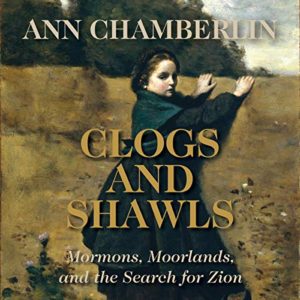 Ann Chamberlin. Clogs and Shawls: Mormons, Moorlands, and the Search for Zion. Narrated by Jacqueline de Boer
Ann Chamberlin. Clogs and Shawls: Mormons, Moorlands, and the Search for Zion. Narrated by Jacqueline de Boer
Ann Chamberlin’s Clogs and Shawls not only tells a social history of a Mormon family but also draws on Chamberlain’s research in her family history. Unlike many published family histories, the story that Chamberlain tells is far from the typical story of Mormon pioneers or life in early Utah. Instead her ancestors join the Church in England in 1901 and stay there for most of the next 50 years before some of them immigrate to Utah. Their tale of their struggles paints a poignant and faithful portrait of resilience amid struggle as a family navigates their way through immigration to a brighter future.
Chamberlain’s rich and vibrant prose, honed from her long career writing historical fiction, is well-rendered in this audiobook despite the challenge of portraying Chamberlain’s structure, which shifts between her well-wrought prose and the multiple related voices of family members who’s interviews Chamberlain included in her narrative. While Chamberlin’s expert prose combined with the engaging narration performed by Jaquelin de Boer make this an enjoyable listen for any audiobook fan, it is the refreshingly unusual setting for a Mormon family history, combined with the integration of first-person interviews which allow Chamberlin’s relatives to recount their story firsthand, which make this work worthy of special consideration by the Mormon literary community as a whole.
Other finalists:
D. J. Butler. Witchy War Series (Witchy Eye, Witchy Winter, Witchy Kingdom)
Benjamin Park. Kingdom of Nauvoo: The Rise and Fall of a Religious Empire on the American Frontier
Fatimah Salleh and Margaret Olsen Hemming. The Book of Mormon for the Least of These, volume 1
The Church of Jesus Christ of Latter-day Saints, Church History Department. Saints, Book 2, No Unhallowed Hand: 1846-1893
Comics
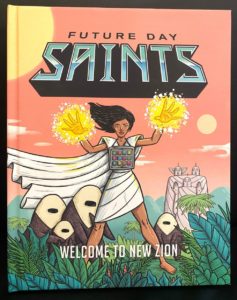 Matt Page. Future Day Saints: Welcome to New Zion
Matt Page. Future Day Saints: Welcome to New Zion
Matt Page’s Future Day Saints: Welcome to New Zion is more than a comic. It’s a celebration of Mormon folklore and urban legend, a subtle satire, and an exploration of an alternate future where these quirks of culture are present across galaxies.
Drawing inspiration from 1980s Saturday morning cartoons (and the toy lines that funded them), Matt tells a story about how the gospel applies to all beings. Celestial parents have brought together many of their children, from humans in multiple star systems to a 9-foot tall skeleton named Z. All of these have been brought together to build New Zion near Kolob. There are heroes and villains—the Valiant and the Curses (including a Bad Bishop who is almost indistinguishable from the Valiant Good Bishop). Even in Zion, there is opposition and opportunities for growth.
Matt has filled his book with backstories, character stats, coloring pages, and full-page “ads” for tie-in action figures. The world he’s created is both fresh and familiar, both faithful and far-fetched. Every re-reading gives an opportunity for noticing new references to early church history or scripture cleverly worked into the art or the stories.
Other finalists:
Dani Jones. Everything Is Going to Be Okay
Andrew G. Knaupp and Sal Velluto. Pillar of Light: Joseph Smith’s First Vision
Brittany Long Olsen. Magic in the Valley: The Story of Moira Green, Witch
Creative Nonfiction
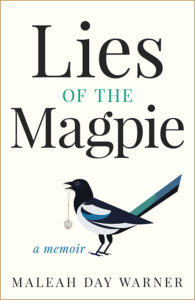 Maleah Day Warner, Lies of the Magpie. Author Academy Elite
Maleah Day Warner, Lies of the Magpie. Author Academy Elite
In Lies of the Magpie, Maleah Day Warner flings the door wide open on her immaculate-on-the-outside life and invites readers to examine all the messes on the inside. These messes—including the hopelessness and feelings of inadequacy that come from trying to juggle the responsibilities of being a spouse, a parent, a church member, and a business owner—are what make Warner’s story so relatable. Readers of all ages and genders will identify with Warner; she is your parent, your partner, your friend, you. She uses literary and rhetorical devices and an approachable writing style to shine a light on things that often get swept under the rug—mental health issues like postpartum depression, inequalities in marriage and parenting, and the pure exhaustion that comes from trying to do it all. She is frank about the conventional and unconventional things she tries along the way as she struggles to align her mind, body, and spirit. Warner’s willingness to put her own life and cognitive distortions under a microscope will help those who are unknowingly struggling with postpartum depression to recognize its symptoms and find their own path to healing.
Other finalists:
Patrick Madden. Disparates
Caitlin Myer. Wiving: A Memoir of Loving Then Leaving the Patriarchy
Criticism
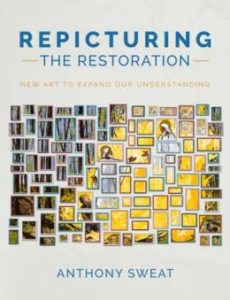 Anthony Sweat. Repicturing the Restoration: New Art to Expand our Understanding. Brigham Young University Religious Studies Center
Anthony Sweat. Repicturing the Restoration: New Art to Expand our Understanding. Brigham Young University Religious Studies Center
In Repicturing the Restoration: New Art to Expand Our Understanding, Anthony Sweat wisely argues, “Faith is a choice. In today’s information age, however, ignorance is not.” Sweat’s answer to such a world is a multi-faceted, multi-genre book of original artwork and commentary that should be welcomed by artists and historians, sinners and saints, and experts and students. It approaches topics ranging from seer stones and polygamy to Liberty Jail and the ordination of Q. Walker Lewis, addressing each in weighty chapters each with their own original artwork and four other sections: a researched historical “Background,” a commentary on the artistic choices made in the “Image” of that chapter, an “Application” that submits insights into various concerns and issues, and “Analysis” that offers fearless questions guaranteed to promote personal thought and further discussion. Sweat aims for his audience to be “inspired, informed, confused, enriched, enlightened, and hopefully edified” by his book, and he accomplishes that goal. The book is a crash-course in analyzing visual religious art, doubling as a glossy conversation starter that can be left lying casually on living room side tables for guests to pick up, peruse, and find themselves absorbed by. It is also a historical narrative of twenty-five, at-times troubling moments from the Church’s past, as well as a contemplative consideration of how those events have shaped—or should have shaped—the current cultural moment. And last but not least, it is an insider’s peek into the mindset of a capable artist/university religion professor as he comments personally and professionally in both art and word on critical questions of today through the lens of yesterday. If knowledge of the past and its controversies are inevitable, then some Saints may buy this book in hopes of pretty pictures, pithy analysis, and easy answers. What they will find is much better: Sweat’s Repicturing the Restoration has artwork depicting moments we may not like to think about, analysis about events we do not fully understand, thoughtful answers to questions we may be afraid to ask, and then more questions that are not aimed to create comfort or easy answers. Whether readers appreciate Sweat’s artistic style, are persuaded by Sweat’s analysis or answers, or take the opportunity to continue discussing Sweat’s forthright questions, Repicturing the Restoration is the book they did not know they needed. But they do. Because what Sweat paints and why he does so is valuable. And what he writes and why he does so is helpful. But how he does so is critical. In the face of tough questions, many of which remain unanswered, Sweat calmly models what he preaches: “broad, deep, mature, abiding, and converting faith” (XI).
Other finalists:
Michael Hicks. Spencer Kimball’s Record Collection: Essays on Mormon Music
Carol Cornwall Madsen, “The “New Woman” and the Woman’s Exponent: An Editorial Perspective”
Ardis E. Parshall and Michael Austin, editors. Josephine Spencer: Her Collected Works, Vol. 1, 1887-1899
Veda Hale, Andrew Hall, Lynne Larson, editors. A Craving for Beauty: The Collected Writings of Maurine Whipple
Drama
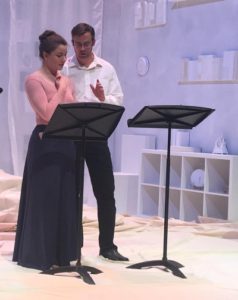 Melissa Leilani Larson. Mountain Law. Women’s Voices Play Festival, Orlando, FL.
Melissa Leilani Larson. Mountain Law. Women’s Voices Play Festival, Orlando, FL.
Mountain Law is an intimate look at the seemingly small life of a woman lost in the broad era of Mormon expansion in the American West. For years, Tamson English is left alone with her children in a tiny cabin in an empty corner of the Utah Territory while her husband starts a new settlement. Though she believes that her isolation is divine punishment for an extramarital affair in her past, the reappearance of her former lover in her life may also be the grace that helps her survive.
This story adds to the canon of Mormon fiction in its unflinching but thoughtful portrayal of the patient human lives that waded through sorrow in service of and obedience to the strictures of a new and unfolding religion. It also creates space for a merciful and understanding God that provides solace in unexpected ways– in a small canary companion, a box of supplies, and an opportunity for love where none would otherwise be given or allowed. Larson’s distinctly theatrical use of the howling wind ties the desolation of Utah’s Ruby Valley to the loneliness and grief in Tamson, and the dreamlike nature of Larson’s movement and dialogue captures the inner world of a single protagonist over the passage of time. Tamson’s story embodies what many Mormon women have endured and continue to endure as they traverse their personal paths of faith, and shows the fortitude and freedom they find along the way. We are pleased to acknowledge Mountain Law as the winner of the 2020 AML Award for Drama.
Other finalists:
Glen Nelson (liberetto) and Lansing McLoskey (music). The Captivity of Hannah Dunston
Ariel Mitchell. Give Me Moonlight
Tom Russell and BYU School of Media Arts Students. Escape from Planet Death
Film
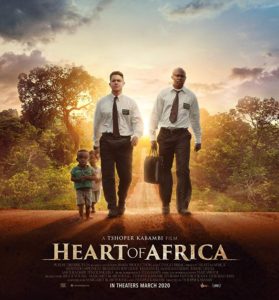 Heart of Africa. Tshoper Kabambi, director, producer, co-writter. Margaret Blair Young, producer, co-writer. Bruce Young, Ephraim Faith Buyikana, and Deborah Basa, producers.
Heart of Africa. Tshoper Kabambi, director, producer, co-writter. Margaret Blair Young, producer, co-writer. Bruce Young, Ephraim Faith Buyikana, and Deborah Basa, producers.
Heart of Africa opens with a mixture of kinetic and ritualistic energy that serve as the backdrop for the rest of the film. We are introduced to Gabriel Ngandu as he runs through the woods of the Democratic Republic of Congo, both literally from a mysterious pursuer and emotionally from the demands of his family and community. As he flees to the city, the missionaries he meets there seem to be his ticket to security and comfort. However, ugly history continues to hound Gabriel, who gradually comes to learn that while his newfound faith offers purpose, hope and healing, he still has to confront the wounds that await him at home.
Heart of Africa checks many boxes of the standard missionary film genre (companion conflict, a girl back home, intense opposition) but does so through the eyes and voice of someone raised entirely outside of the Utah paradigm. The result dares to pose tough questions about the cost of atoning for the past, both through the errors of our protagonist and the deep scars of colonialism. The echoes of Conrad’s Heart of Darkness keep viewers watching carefully for intertextual clues, without overpowering the main story. Most joyfully, as the church continues to become more global, this film hints at what future Mormonism might look like as a growing number of autochthonous testimonies and histories claim their place at the table.
Other finalist:
Gruff. Directed by Kohl Glass, produced by Dallin Cerva and Jacquelyn Cerva.
Middle Grade Novel
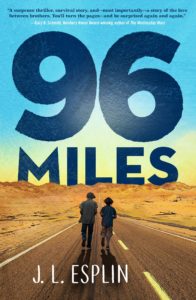 J.L. Esplin. 96 Miles. Starscape/Tor Teen
J.L. Esplin. 96 Miles. Starscape/Tor Teen
With an always-prepared survivalist for a father, the Lockwood brothers have never needed to worry about what would happen to them in an emergency situation. Their dad has stockpiled enough food, water, and other gear to last them through two apocalypses. When disaster strikes while their father is out of town, the boys figure they’ll hunker down and wait it out. Then, a group of men rob the boys at gunpoint, carting out almost all the emergency supplies their dad had so carefully collected. Scared and on their own, the brothers have little choice but to walk to the ranch of a family friend. With 96 miles between where they are and where they need to be, they set out on a terrifying journey where every kind of danger—from hunger to sunburn to wildlife to armed men—waits for them. They will have to call on every ounce of survival advice their father ever gave them as well as their own tenacity and courage in order to survive.
96 Miles is an engrossing page-turner that features likable, sympathetic characters; a vivid, atmospheric setting; and a compelling, action-packed plot. Like all books of this type, it asks intriguing questions about survival—How far would you go to save yourself and your loved ones? With only limited resources available, would you share what you have or keep it for yourself? Perhaps most importantly, would you be able to live with the consequences of whatever actions you decide to take? All of these questions are addressed in the story, making it as thought-provoking as it is riveting. 96 Miles is especially well-written, well-plotted, and multi-layered, especially considering it is a debut novel. While it deals with tough subjects, it never gets too bleak or terrifying for its middle-grade audience.
Other finalists:
Sarah Allen. What Stars are Made Of
Cindy Baldwin. Beginners Welcome
Yamile Saied Mendez. On these Magic Shores
Celesta Rimington. The Elephant’s Girl
Novel
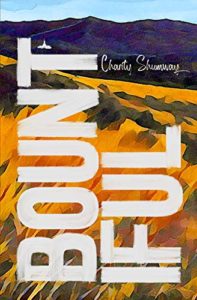 Charity Shumway. Bountiful. BCC Press
Charity Shumway. Bountiful. BCC Press
Newcomer to Mormon fiction Charity Shumway gives a thoughtful and nuanced portrait of contemporary Mormonism in her novel Bountiful. In the novel, Nedra, an empty-nester, looks for new purpose in her life now that her children are grown, while her daughter Heather searches for her place in the church as a single woman who has questions about the doctrines and culture of her childhood faith. Through these two characters, Shumway presents contrasting views of many of the current hot topics of Mormon culture: patriarchy, historical questions, gender relations, LGBT members, and the place of singles in a family-oriented faith.
Refreshingly, neither the traditional nor the questioning side is portrayed as either right or misguided. Shumway avoids writing a novel that presumes the answers to the questions everyone is asking. There are no strawmen here, only people that feel like our neighbors, our siblings, our friends. In the end, the characters discover that in spite of their differences, they need each other, and what’s more, they care about each other. In the end, Bountiful walks the line of optimism about Mormonism’s future without diminishing the seriousness of the problems we face.
Other finalists:
Phyllis Barber. The Desert Between Us
Rick Grunder. 116
Twila Newey. Sylvia
Mahonri Stewart. A New Age of Miracles
Picture Book
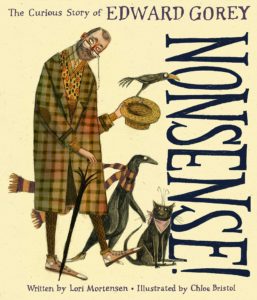 Lori Mortensen and Chloe Bristol. Nonsense: The Curious Story of Edward Gorey. HMH Books for Young Readers
Lori Mortensen and Chloe Bristol. Nonsense: The Curious Story of Edward Gorey. HMH Books for Young Readers
Born in 1825, Edward Gorey was a self-taught voracious reader who loved stories. Drafted into the army at 18 where he spent some time in Dugway, Utah. Edward eventually attended Harvard where he mingled with writers and poets but didn’t know what he wanted to do with his life. He got a job in the art department of a large New York publisher working on the books written by others. One day, Gorey had an epiphany “What about the books he wanted to write? That’s when it happened. Voilà!” Edward Gorey’s path was set. The author of over 100 books, Edward Gorey was also the inspiration for numerous creators, including Daniel Handler, Tim Burton and Neil Gaiman.
Lorie Mortensen provides a rhythm and mood that perfectly depicts and honors the subject while Illustrator Chloe Bristol injects Gorey-like humor and atmosphere into the pages. The conversational tone, often directly addressing questions to the reader, has the effect of not only capturing but maintaining interest throughout the book. Through words and illustrations this picture book biography brilliantly pays homage to a curious man.
Other finalists:
Amanda Rawson Hill and Joanne Le-Vriethoff. You’ll Find Me
Carol Lynn Pearson and Jane Sanders. I’ll Walk with You
Kristyn Crow and Annie Won. All Aboard the Moonlight Train
Podcast
 Dialogue Book Report.Dialogue: A Journal of Mormon Thought. Hosted by Andrew Hall and produced by Daniel Foster Smith. Judged episodes featuring D.J. Butler, Jaclyn Foster, Conor Hilton, Adam McLain, and Mattathias Westwood.
Dialogue Book Report.Dialogue: A Journal of Mormon Thought. Hosted by Andrew Hall and produced by Daniel Foster Smith. Judged episodes featuring D.J. Butler, Jaclyn Foster, Conor Hilton, Adam McLain, and Mattathias Westwood.
The Dialogue Book Report’s focus on Mormon fiction, poetry, and creative nonfiction provides an invaluable service to the field of Mormon literature. But even more than that, by bringing authors, scholars, and critics together, it fosters conversations that provide deeper context and broader scope than individual author interviews. The two submitted episodes “#4: Recent books on LGBTQ issues and Mormonism” and “#7: D.J. Butler” were notable in the way they not only cover current ground by focusing on recently published books, but also sketch out interesting future directions for writers in the field and make strong cases for the importance of literature to Mormon culture.
In addition, whether due to the production or the guests–or most likely both–Dialogue Book Report episodes are uniformly crisp and smooth in sound quality and editing, which makes them a pleasure to listen to.
Other finalists:
The Center’s Studio Podcast. Center for Latter-day Arts. Hosted by Glen Nelson
Mattathias Reads the World. Hosted by Mattathias Westwood
Unfinished: Short Creek. Witness Docs from Stitcher. Hosted by Ash Sanders and Sarah Ventre
Poetry
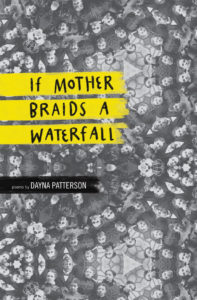 Dayna Patterson. If Mother Braids a Waterfall. Signature Books
Dayna Patterson. If Mother Braids a Waterfall. Signature Books
If, unlike Dayna Patterson, you didn’t grow up in a bedroom bookstore but still “haunt bookstores,” as the late Lawrence Ferlinghetti advised, you’ll find in If Mother Braids a Waterfall an invocation of individualism that rings with top-shelf singularity, a resplendent reclamation in language that could out-freshen Eden. Patterson’s vision ranges from atomic to cosmic, delivering satirical-sincere pronouncements that “The Mormons Are Coming,” that “The Post-Mormons Are Leaving,” and, with startling clarity and lyricism, that she is “Still Mormon,” the way “scars glisten,” the way “the peach tree drops its one swelling / to the ground,” and the way a “poem is a room / and refuses the period’s lock.” In these sparkling confluences and cross currents, Patterson saves space for impish irreverence: odes to polygamy, deity in drag, the mercies of ordinary mud, Star Trek or pioneer trek?—you choose. But Patterson’s master mode is an elevated swerve into the sublime, inviting us into exalted audacities and untethered raptures of praise for the women from her history and multiversal theologies, the Ellens and Susannahs in her generational line, mothers and grandmothers and wives of Brigham Young, along with the mystical matriarch “Eloher,” who “season[s] everything” and “hurtle[s] millions / of lightyears to be near / us.” If Mother Braids a Waterfall doubles as revitalizing weave and awakening deluge, mixing voices of devotion and deviation with radiant reveries and, at times, sharp spiritual sunderings. Read and behold a reverberating language revival, a great awakening of verbs: the Mother God that “caterpillar[s] across the page / of our thoughts,” the female seahorse that “tendrils her tail around his.” Like the “grandgirl clacking her claws” in “Dear Grandpa,” these poems pinch back, bringing blood to the surface, dowsing readers in a refreshing roar of awareness. Read and unravel in the torrent.
Other finalists:
Michael R. Collings. I, Taliesin
Gabriel González Núñez. Ese golpe de luz
Melody Newey Johnson. An Imperfect Roundness
Religious Nonfiction
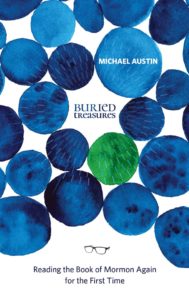 Michael Austin. Buried Treasures: Reading the Book of Mormon Again for the First Time. BCC Press
Michael Austin. Buried Treasures: Reading the Book of Mormon Again for the First Time. BCC Press
Michael Austin’s Buried Treasures is scriptural exegesis, perhaps the classic definition of Religious Nonfiction. What sets this volume apart from many other treatments of the Book of Mormon is that Austin is an academic who practices and teaches literary criticism, teasing out meanings from texts that goes beyond just what is written on a page. In 2016, Austin decided to reengage the Book of Mormon by doing a close reading cover to cover, employing the tools of analysis that he has employed with other texts, both religious and secular.
As the title suggests, Austin found ideas and narrative complexity that rivaled anything that he had experienced with the biblical texts he had previously examined. Austin indeed found buried treasures within the Book of Mormon text, and wrote about his experience in weekly blog posts for an entire year. Buried Treasures is the result of converting those many posts into a brief but comprehensive examination of what we often miss in our casual readings of the Book of Mormon. As he puts it, “…words are only a small part of what we talk about when we talk about meaning.”
Austin’s treatment of the text serves to upend some of our traditional understanding of the Book of Mormon. Yes, as the Church of Jesus Christ of Latter-day Saints claims, it is another testament of Jesus Christ. But it also is a powerful rejection of some of the simplistic ideas we have acquired from casual reading and proof-texting of the Church’s foundational scripture. Austin is our guide as we reevaluate our own understanding of narratives in the Book of Mormon, challenging our assumptions, always asking us to look closer, and frame better questions. Buried Treasures: Reading the Book of Mormon Again for the First Time is itself a buried treasure, asking us to make a paradigm shift in our reading of this unique scripture, and find our own treasures within it.
Other finalists:
Lavina Fielding Anderson. Mercy without End
William L. Davis. Visions in a Seer Stone; Joseph Smith and the Making of the Book of Mormon
Taylor G. Petrey. Tabernacles of Clay: Sexuality and Gender in Modern Mormonism
Fatimah Salleh and Margaret Olsen Hemming. The Book of Mormon For the Least of These, volume 1: 1 Nephi-Words of Mormon
Short Fiction
 Ryan Shoemaker. “The Water Between Us”. Barzakh 12, Spring 2020
Ryan Shoemaker. “The Water Between Us”. Barzakh 12, Spring 2020
In Ryan Shoemaker’s short story, “The Water Between Us,” it’s the middle of the Great Recession and Spencer can’t find work. Four years earlier, when Spencer and his wife, Anne, got married, they had no reason to doubt that Spencer would always be employed in the construction industry. Maybe he could even run his own company someday. Anne’s future was mapped out as well: she would finish her associate’s degree and work until a baby came. But now Spencer is stuck at home watching Ronco Rotisserie infomercials while Anne, pregnant with their first child, has risen quickly through the ranks of a biotech firm and set her sights on an MBA. Spencer and Anne both grew up singing the same Primary songs—they learned the proper roles of mother and father, of husband and wife—but the sand is shifting beneath their feet. “I keep thinking,” Anne says, “that there’s the life we talked about, the life we’re expected to live, the life our parents lived, and then there’s the life we have to live.”
Shoemaker does not reduce Spencer or Anne to trite stereotypes. Rather than being jealous of his wife’s success, Spencer is thoughtful and open to altering his life’s plan, more worried about disappointing his parents than aggrieved about not receiving his due. Anne, too, is gentle with her husband, maintaining a steady encouragement and a belief that, somehow, they can both achieve their dreams. The pressure of cultural expectation bears down on both of them, but the story is infused with a hopeful buoyancy. Shoemaker’s rhythmic prose and luminous imagery makes what could have been a heavy, predictable story about the weight of Latter-day Saint gender roles into something much brighter, and more true.
Other finalists:
Ryan Habermeyer. “Every Nerve Singing”
M.K. Hutchins, “Upcycling Death”
William Morris. “Certain Places”
Maurine Whipple. “The Overcoat”
Short Fiction Collection
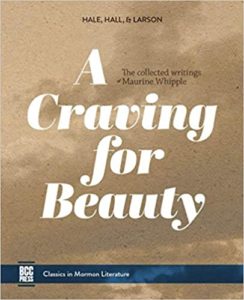 Maurine Whipple. A Craving for Beauty: The Collected Writings of Maurine Whipple. BCC Press. Edited by Veda Hale, Andrew Hall, and Lynne Larson
Maurine Whipple. A Craving for Beauty: The Collected Writings of Maurine Whipple. BCC Press. Edited by Veda Hale, Andrew Hall, and Lynne Larson
Writing began to be a religion with me . . . now I know it must have been desperation—a craving for beauty and escape from the ugliness of reality. Maurine Whipple
The timing of the publication of The Giant Joshua coincided with the advent of World War II; consequently, a major literary event was eclipsed by a cataclysmic event. A Craving for Beauty gives the work of one of the most talented writers of that century a second viewing. Whipple was more than a “Mormon” writer; her skill as a writer identifies her as a master. She writes what she knows: polygamy, marital relationships, unrequited romance, and the subduing of the American West. She doesn’t promote or denigrate any particular ideology; instead, she reveals through her characters and her descriptions the motivation, the cultural limitations, and the harsh realities faced by the people who inhabited the Great Basin. This anthology includes her early work, lectures, short fiction, and sections of subsequent novels she never completed. It is a treasure trove.
The introductory material that precedes each selection provides the historical context, but equally as interesting is the biographical detail, the descriptions of what was occurring in Whipple’s life at the time she was writing each piece. A century has passed since Whipple began writing, and A Craving for Beauty proves that both her work and her life remain worthy of serious study.
Other finalist:
Eric James Stone. The Humans in the Walls and Other Stories
Young Adult Novel
 Yamile Saied Méndez. Furia. Algonquin Young Readers
Yamile Saied Méndez. Furia. Algonquin Young Readers
Set in Argentina, Yamile Saied Méndez’ Furia shares the story of teen-aged Camilla Hassan, a rising youth soccer sensation, who pursues her athletic dreams because of both her love for the game and the opportunities it opens. Her skills on the field are unparalleled and her passion for the “beautiful game” can only be complicated by Diego, a longtime friend and recently signed Juventus megastar who is recognized as one of the best soccer players in the world. Now, Camilla must decide whether a romantic relationship with Diego—and the riches and glamour that comes with it—is worth pausing her own dreams.
Mendez’s novel convincingly portrays Argentine culture through story, community, and friends. Artistically portraying both Camilla’s ambition and responsibility, Méndez’s work can inspire young women everywhere to pursue their dreams and trust themselves when faced with difficult decisions. Readers of all ages will be rooting for Camilla both on and off the field.
Other finalists:
Teri Bailey Black. Chasing Starlight
Dean Hughes. Displaced
Tricia Levenseller. The Shadows Between Us
Kara McDowell. One Way or Another
